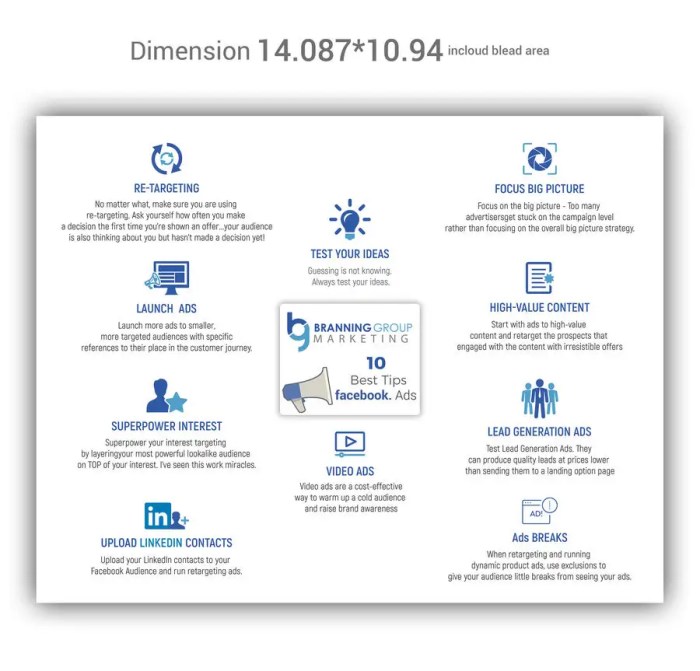Facebook Advertising Tips are essential for any business looking to level up their marketing game. With the right strategies, you can reach your target audience effectively and maximize your ROI.
Get ready to dive into the world of Facebook advertising and discover how you can take your campaigns to the next level.
Introduction to Facebook Advertising Tips

In today’s digital age, Facebook advertising has become a crucial tool for businesses looking to expand their reach and connect with their target audience. With over 2.7 billion monthly active users, Facebook offers a vast platform for businesses to promote their products or services effectively.
Importance of Facebook Advertising
- Facebook advertising allows businesses to target specific demographics, interests, and behaviors, ensuring that ads reach the right audience.
- It provides a cost-effective way to increase brand awareness and drive traffic to a website or landing page.
- With detailed analytics and insights, businesses can track the performance of their ads and make data-driven decisions to optimize their campaigns.
Benefits of Using Facebook Advertising
- Increased brand visibility and recognition among a wide audience.
- Ability to create highly targeted ads based on demographics, interests, and behaviors.
- Cost-effective advertising options suitable for businesses of all sizes.
- Access to detailed analytics and performance metrics to measure the success of ad campaigns.
- Opportunity to engage with customers through comments, messages, and interactions on the platform.
Understanding the Facebook Advertising Platform

Facebook offers a variety of ad types, each serving a different purpose to help businesses reach their target audience effectively. Here are some of the main types of Facebook ads available:
Types of Facebook Ads
- Image Ads: Static ads that include a single image to grab the audience’s attention.
- Video Ads: Dynamic ads that use videos to convey a message or showcase a product/service.
- Carousel Ads: Interactive ads that allow multiple images or videos to be displayed in a scrollable format.
Targeting Options
Facebook provides a wide range of targeting options to help advertisers reach specific audiences based on demographics, interests, behaviors, and more. Some of the targeting options include:
- Location: Target users based on their geographical location.
- Interests: Target users based on their interests and activities on Facebook.
- Demographics: Target users based on age, gender, education, and other demographic factors.
Budgeting and Bidding Strategies
When it comes to budgeting and bidding on Facebook ads, advertisers have several options to optimize their ad campaigns. Some key strategies include:
- Set a Daily or Lifetime Budget: Advertisers can choose to set a daily budget or a lifetime budget for their ad campaigns.
- Choose a Bidding Strategy: Facebook offers different bidding strategies such as cost per click (CPC), cost per thousand impressions (CPM), or cost per conversion (CPA).
- Monitor Performance: It’s crucial to monitor the performance of ad campaigns regularly and make adjustments to optimize results.
Creating Engaging Ad Content
To stand out on Facebook, it’s crucial to create ad content that grabs attention and resonates with your target audience. From visually appealing creatives to compelling ad copy, here are some tips to help you craft engaging Facebook ads.
Designing Visually Appealing Ad Creatives
When it comes to designing ad creatives for Facebook, remember that visuals are key. Make sure your images or videos are high-quality, relevant to your message, and eye-catching. Use bright colors, clear fonts, and striking visuals to capture the user’s attention as they scroll through their feed.
The Importance of Compelling Ad Copy
In addition to visuals, your ad copy plays a crucial role in capturing audience attention. Craft a clear and concise message that highlights the value proposition of your product or service. Use persuasive language, call-to-action phrases, and compelling storytelling to drive engagement and conversions.
Examples of Successful Facebook Ad Campaigns
Looking at successful Facebook ad campaigns can provide inspiration for your own creative elements. For example, Airbnb’s “Live There” campaign featured stunning visuals of unique travel destinations, paired with engaging copy that emphasized the local experience. Another great example is Nike’s “Just Do It” ads, which use powerful imagery and motivational messaging to connect with their audience.
Remember, the key to creating engaging ad content on Facebook is to strike a balance between visually appealing creatives and compelling ad copy that resonates with your target audience.
Optimizing Ad Performance
When it comes to maximizing the effectiveness of your Facebook ads, tracking and analyzing their performance is key. By understanding how your ads are performing, you can make informed decisions on how to optimize them for better results.
Tracking and Analyzing Performance
Tracking the performance of your Facebook ads involves monitoring key metrics such as click-through rates, conversion rates, and cost per acquisition. Analyzing this data can provide valuable insights into what is working well and what needs improvement.
- Utilize Facebook Ads Manager to track ad performance in real-time.
- Look for patterns in the data to identify trends and areas for optimization.
- Use tools like Google Analytics to gain a deeper understanding of user behavior after clicking on your ads.
A/B Testing Strategies, Facebook Advertising Tips
A/B testing is a powerful tool for optimizing ad content and targeting. By testing different variations of your ads and analyzing the results, you can determine which elements are most effective in driving conversions.
- Create multiple versions of your ads with variations in copy, images, and targeting parameters.
- Run the different ad variations simultaneously to compare performance metrics.
- Use the data from A/B tests to refine your ad campaigns and focus on what resonates most with your target audience.
Adjusting Ad Campaigns
Based on the performance metrics you gather from tracking and A/B testing, it’s crucial to make adjustments to your ad campaigns to optimize their performance further.
- Pause underperforming ads and reallocate budget to top-performing ones.
- Experiment with different ad formats and placements to see which drive the best results.
- Regularly review and update your targeting parameters to reach the most relevant audience for your ads.
Leveraging Facebook Pixel for Better Results: Facebook Advertising Tips
Utilizing Facebook Pixel can greatly enhance your Facebook advertising strategy by providing valuable data insights that can help you track conversions, optimize ads, and improve ROI.
Facebook Pixel is a piece of code that you place on your website to track user behavior and interactions. By using Facebook Pixel, you can gain a better understanding of your audience, track conversions from your ads, and optimize your ad campaigns for better results.
Setting Up and Installing Facebook Pixel
To set up and install Facebook Pixel on your website, follow these steps:
- Create a Facebook Pixel in your Facebook Ads Manager account.
- Copy the generated Pixel code.
- Paste the Pixel code into the header section of your website.
- Verify that the Pixel is working correctly using Facebook’s Pixel Helper tool.
Advanced Tips for Utilizing Facebook Pixel Data
Once your Facebook Pixel is up and running, here are some advanced tips for leveraging the data to improve your ad targeting and ROI:
- Use Pixel data to create custom audiences based on user behavior on your website.
- Set up conversion tracking to measure the effectiveness of your ad campaigns.
- Implement dynamic ads to retarget users who have interacted with your website or products.
- Optimize your ad campaigns based on Pixel data insights to improve performance and drive better results.
Compliance and Best Practices
Facebook’s advertising policies and guidelines are crucial to follow to ensure your ads are not rejected or your account is not penalized. It’s important to understand what is allowed and what is not allowed on the platform to maintain a successful advertising strategy.
Ad Content Guidelines
- Ensure your ad content is accurate and truthful. Avoid using misleading information or false claims.
- Avoid using offensive language, images, or videos in your ads. Facebook has strict guidelines against content that may be considered inappropriate.
- Respect intellectual property rights and do not use copyrighted material without permission.
Targeting Practices
- Target your ads responsibly and avoid discrimination based on characteristics like race, gender, or age.
- Use audience targeting options provided by Facebook to reach the right people without resorting to discriminatory practices.
Compliance with Data Privacy Regulations
- Ensure that your ads comply with data privacy regulations such as GDPR. Obtain consent when collecting personal information from users.
- Be transparent about how user data is used and provide clear privacy policies on your website or landing page.
Monitoring and Optimization
- Regularly monitor the performance of your ads to ensure they are compliant with Facebook’s guidelines.
- Optimize your ads based on feedback and insights to improve results while maintaining compliance.
